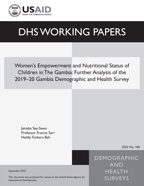- PUBLICATIONS
- JOURNAL ARTICLES
- ACCESS PUBLICATIONS
Publications Summary
- Document Type
- Working Papers
- Publication Topic(s)
- Child Health and Development, Gender, Nutrition
- Country(s)
- Gambia
- Language
- English
- Recommended Citation
- Sey-Sawo, Jainaba, Francis Sarr, and Haddy Tunkara Bah, 2022. Women’s Empowerment and Nutritional Status of Children in The Gambia: Further Analysis of the 2019–20 Demographic and Health Survey. DHS Working Papers No. 184. Rockville, Maryland, USA: ICF.
- Download Citation
- RIS format / Text format / Endnote format
- Publication Date
- September 2022
- Publication ID
- WP184
Download
 Women’s Empowerment and Nutritional Status of Children in The Gambia: Further Analysis of the 2019–20 Gambia Demographic and Health Survey (PDF, 732K)
Women’s Empowerment and Nutritional Status of Children in The Gambia: Further Analysis of the 2019–20 Gambia Demographic and Health Survey (PDF, 732K)
Download this publication
There is no printed copy available to order.
